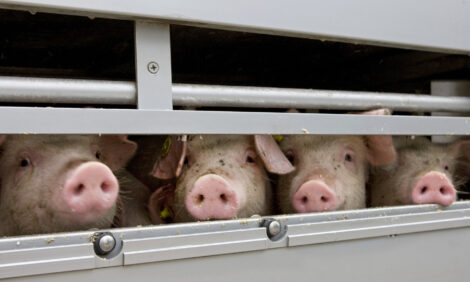



Increased EU Pig Production and Drop in Prices Forecast
EU - In 2014, EU pig meat production started recovering from the low 2013 level supported by lower feed costs and increased productivity, according to the latest European Commission 'Short Term Outlook for EU Arable Crops, Dairy and Meat Markets in 2015 and 2016'.Production developments in the EU-15 have been different from country to country; increases took place in Spain (3.7 per cent), Portugal (4.1 per cent), the United Kingdom (3.5 per cent) and the Netherlands (5.3 per cent), declines in Germany (-0.8 per cent ) and Italy (-2.0 per cent) while production in France and Denmark remained stable.
Despite the appearance of African Swine Fever (ASF) at the beginning of 2014, the production increase in Poland has been particularly strong (almost nine per cent) and, together with an increase by more than 10 per cent in Hungary and Romania, it brought EU-N13 total net production to around 3.5 million tonnes (or +5.4 per cent on a yearly basis).
After several years of contraction in the number of pigs, preliminary December 2014 livestock survey data indicated an increase by 1.2 per cent; breeding sows increased by 0.4 per cent, thanks to Spain (4.7 per cent) and the Netherlands (1.0 per cent), while in Poland, it remained stable.
A stronger increase is shown in piglet numbers (2.4 per cent), of which Spanish pig population rose by 12 per cent, Denmark three per cent, the Netherlands four per cent and Portugal seven per cent .
Despite the current low prices, a higher pig herd and increased productivity following the implementation of welfare rules in the sow sector should create conditions for a continuous recovery in production over the projection period at around 23 million tonnes.
In the absence of the Russian outlet since February 2014, EU pig meat exports (including lard but without offal) dropped by around 13 per cent in 2014, and this despite re-orientation to alternative markets.
Due to the restrictions imposed on EU meat, in 2014, Russia accounted for a mere three per cent of EU pig meat exports compared to 33 per cent a year earlier.
Strong demand from the Asian markets, particularly from Japan (totalling 345,000 tonnes), South Korea (199,000 tonnes), Hong-Kong (125,000 tonnes) and the Philippines (122,000 tonnes) did not fully compensate for the loss of the Russian market.
However, prospects of higher pig meat supplies and strong demand from Asia could support a recovery so that exports could reach the 2012 level by 2016 (2.1 million tonnes).
Despite a sustained recovery in consumption, the strong drop in EU exports and increased supply on the domestic market drove pig meat prices down below their 2007-11 average, at €133 per 100kg in the last week of 2014.
On 24 February 2015, the European Commission announced the opening of a private storage aid scheme for pig meat to stimulate pig prices recovering faster and to stabilise producer margins.
Uncertainties
The forecasts are elaborated based on the assumption that the one-year Russian import ban end in August 2015, but the duration of this ban remains far from certain.
In addition, the export performance of the EU is supported by the depreciation of the Euro against the US dollar. Export forecast might be affected by significant changes in the exchange rate.
Last but not least, experience has shown the oil price could develop unexpectedly, thus bringing additional uncertainty to the agricultural markets.








